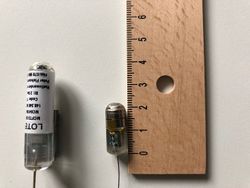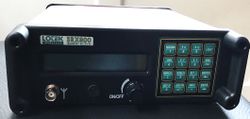Difference between revisions of "Radio telemetry"
Bendikhansen (talk | contribs) |
|||
| (5 intermediate revisions by 2 users not shown) | |||
| Line 1: | Line 1: | ||
=Quick summary= | =Quick summary= | ||
| − | + | [[file:radio_transmitter.jpg|thumb|250px|Figure 1: Two radio transmitters of different size (FCO)]] | |
| − | [[file:radio_transmitter.jpg|thumb|250px|Figure 1: | + | [[file:radio_receiver.jpg|thumb|250px|Figure 2: Radio telemetry receiver (FCO).]] |
| − | [[file:radio_receiver.jpg|thumb|250px|Figure 2: | + | [[file:fish_transmitter.jpg|thumb|250px|Figure 3: Brown trout (Salmo trutta) with a radio transmitter in the body cavity and the external antenna (FCO).]] |
| − | [[file:fish_transmitter.jpg|thumb|250px|Figure 3: Brown trout (Salmo trutta) with a radio transmitter in the body cavity and the external antenna.]] | ||
| Line 28: | Line 27: | ||
Stationary and mobile tracking are often used. Stationary tracking continuously tracks a signal, but its application is limited to specific sites. Fish presence or absence at a site, and passage and movement rates between sites can be detected (Eiler, 2012). Mobile tracking allows the survey of an extended area. | Stationary and mobile tracking are often used. Stationary tracking continuously tracks a signal, but its application is limited to specific sites. Fish presence or absence at a site, and passage and movement rates between sites can be detected (Eiler, 2012). Mobile tracking allows the survey of an extended area. | ||
| − | The application for radio telemetry at hydropower plants is mainly detecting passage routes and linear migrations in a river system. However, acoustic telemetry | + | The application for radio telemetry at hydropower plants is mainly detecting passage routes and linear migrations in a river system. However, [[acoustic telemetry ]] became very popular and is more suitable for studies with the goal of documenting the detailed behaviour patterns of fishes in front of a hydropower plant (forebay). There are certain advantages and disadvantages for acoustic and radio telemetry. Both methods are adequate depending on the study objectives. |
Radio telemetry is applied worldwide. Beeman et al (2012) published a comprehensive study on the effects of hydroelectric dams on fish populations on the Columbia River and on the Snake River. The downstream migration of Chinook salmon and anadromous rainbow trout at different sites were extensively documented. | Radio telemetry is applied worldwide. Beeman et al (2012) published a comprehensive study on the effects of hydroelectric dams on fish populations on the Columbia River and on the Snake River. The downstream migration of Chinook salmon and anadromous rainbow trout at different sites were extensively documented. | ||
| Line 34: | Line 33: | ||
Radio telemetry studies will be applied within the FIThydro project in the Aare River (HP Bannwil) to study the migration corridor and the timing of the migration. Mainly cyprinid fish species will be tracked. The main question is if fish are using the spillway corridor or if they migrate with the main flow through the turbine intakes. On the whole, the downstream migration of cyprinid fish species at hydropower plants has been incompletely studied so far and the Bannwil Test Case should contribute to a better understanding of cyprinid fish migration. | Radio telemetry studies will be applied within the FIThydro project in the Aare River (HP Bannwil) to study the migration corridor and the timing of the migration. Mainly cyprinid fish species will be tracked. The main question is if fish are using the spillway corridor or if they migrate with the main flow through the turbine intakes. On the whole, the downstream migration of cyprinid fish species at hydropower plants has been incompletely studied so far and the Bannwil Test Case should contribute to a better understanding of cyprinid fish migration. | ||
| + | =Relevant mitigation measures and test cases= | ||
| + | {{Suitable measures for 3D fish tracking system}} | ||
=Other information= | =Other information= | ||
| Line 39: | Line 40: | ||
=Relevant literature= | =Relevant literature= | ||
| − | *Beeman, J. W., E. E. Hockersmith & J. R. Stevenson. 2012. Design and performance of radio telemetry systems for assessing juvenile fish passage at three hydroelectric dams. Pages 281-302 in N. S. Adams, J. W. Beeman & J. H. Eiler. Editors. Telemetry techniques: a user guide for fisheries research. American Fisheries Society, Bethesda, Maryland. | + | *Beeman, J. W., E. E. Hockersmith & J. R. Stevenson. (2012). Design and performance of radio telemetry systems for assessing juvenile fish passage at three hydroelectric dams. Pages 281-302 in N. S. Adams, J. W. Beeman & J. H. Eiler. Editors. Telemetry techniques: a user guide for fisheries research. American Fisheries Society, Bethesda, Maryland. |
| − | *Eiler, J. H. 2012. Tracking aquatic animals with radio telemetry. Pages 163-204 in N. S. Adams, J. W. Beeman & J. H. Eiler. Editors. Telemetry techniques: a user guide for fisheries research. American Fisheries Society, Bethesda, Maryland. | + | *Eiler, J. H. (2012). Tracking aquatic animals with radio telemetry. Pages 163-204 in N. S. Adams, J. W. Beeman & J. H. Eiler. Editors. Telemetry techniques: a user guide for fisheries research. American Fisheries Society, Bethesda, Maryland. |
[[Category:Methods]] | [[Category:Methods]] | ||
Latest revision as of 15:15, 1 June 2020
Contents
Quick summary
Date:
Type: Method
Introduction
Radio telemetry is mainly used in freshwater (shallow streams and rivers) with a conductivity of < 500-1000 µSiemens/cm. A radio transmitter emits electromagnetic energy in the radio frequency range (between 30-300 MHz) and provides a possibility for remotely locating a fish. Digitally coded transmitters emit a unique code. A system can operate up to 1000 coded transmitters on one single frequency.
It is a gear intensive technique with the following components:
- Transmitter, emitting the signal, attached to the fish, with battery and an antenna (Figure 1)
- Mobile or fixed receiving antenna, capturing the radio signal, different types available; often loop or Yagi antenna are used.
- Receiver, converting the radio signal into an electronic/audible form in order to identify the tagged fish (Figure 2)
- Data logger, operates the receiver when the operator is absent
- Cables/connectors connect the antenna to the receiver
The transmitters should be adjusted to the size of fish and the study goal. The transmitter weight should not exceed 2 % of the fish weight. Different sensors can record temperature, depth, and pressure. Miniaturization made transmitters with 0.2 g possible. Therefore small fishes (12-15 cm total length) can be equipped with these tiny transmitters.
The transmitters are implanted into the body cavity of the fish (Figure 3). Gastric (oesophagus) insertion or external attachment may be possible. The conductivity of the water and the depth of the transmitter in the river are the most critical parameters in detecting the radio signals.
Application
Radio telemetry is a standard tool for the study of spatial ecology and migration of fishes. It can be applied for a variety of fish migration studies. The passage corridor at a hydropower plant can be evaluated and information is gathered how the fish is approaching the site. The searching phase in front of a hydropower plant can be documented for downstream and upstream migrations.
Stationary and mobile tracking are often used. Stationary tracking continuously tracks a signal, but its application is limited to specific sites. Fish presence or absence at a site, and passage and movement rates between sites can be detected (Eiler, 2012). Mobile tracking allows the survey of an extended area.
The application for radio telemetry at hydropower plants is mainly detecting passage routes and linear migrations in a river system. However, acoustic telemetry became very popular and is more suitable for studies with the goal of documenting the detailed behaviour patterns of fishes in front of a hydropower plant (forebay). There are certain advantages and disadvantages for acoustic and radio telemetry. Both methods are adequate depending on the study objectives.
Radio telemetry is applied worldwide. Beeman et al (2012) published a comprehensive study on the effects of hydroelectric dams on fish populations on the Columbia River and on the Snake River. The downstream migration of Chinook salmon and anadromous rainbow trout at different sites were extensively documented.
Radio telemetry studies will be applied within the FIThydro project in the Aare River (HP Bannwil) to study the migration corridor and the timing of the migration. Mainly cyprinid fish species will be tracked. The main question is if fish are using the spillway corridor or if they migrate with the main flow through the turbine intakes. On the whole, the downstream migration of cyprinid fish species at hydropower plants has been incompletely studied so far and the Bannwil Test Case should contribute to a better understanding of cyprinid fish migration.
Relevant mitigation measures and test cases
Other information
Radio telemetry is gear-intensive with high initial costs for the equipment, but also for transmitters, the preparation and station installation. Radio telemetry experiments have to be considered as animal experiments and special permissions from the local authorities are needed.
Relevant literature
- Beeman, J. W., E. E. Hockersmith & J. R. Stevenson. (2012). Design and performance of radio telemetry systems for assessing juvenile fish passage at three hydroelectric dams. Pages 281-302 in N. S. Adams, J. W. Beeman & J. H. Eiler. Editors. Telemetry techniques: a user guide for fisheries research. American Fisheries Society, Bethesda, Maryland.
- Eiler, J. H. (2012). Tracking aquatic animals with radio telemetry. Pages 163-204 in N. S. Adams, J. W. Beeman & J. H. Eiler. Editors. Telemetry techniques: a user guide for fisheries research. American Fisheries Society, Bethesda, Maryland.


